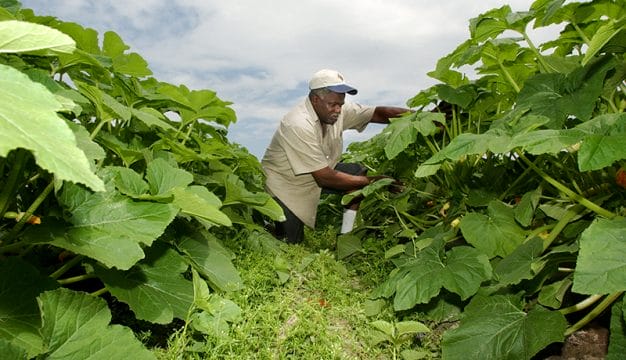Barbecue, Alabama Style
 Vinegar-based Sauce
Barbecue is the age-old art and science of slow-cooking meat. It is worshipped in the state of Alabama, from pecan-infused pork shoulder in Mobile near the coast to white sauce-soaked chicken on the banks of the Tennessee River. Many barbecue restaurants in Alabama are long-time operations that have been run by the same family for generations, and others have proved to be successful second careers for many entrepreneurs. Pork is most commonly barbecued in Alabama in the form of ribs, shoulder or butt, and ham, although some restaurants also feature chicken, brisket, and beef ribs.
Vinegar-based Sauce
Barbecue is the age-old art and science of slow-cooking meat. It is worshipped in the state of Alabama, from pecan-infused pork shoulder in Mobile near the coast to white sauce-soaked chicken on the banks of the Tennessee River. Many barbecue restaurants in Alabama are long-time operations that have been run by the same family for generations, and others have proved to be successful second careers for many entrepreneurs. Pork is most commonly barbecued in Alabama in the form of ribs, shoulder or butt, and ham, although some restaurants also feature chicken, brisket, and beef ribs.
Alabama joins Arkansas, Georgia, South Carolina, North Carolina, Kentucky, and Tennessee in the southern barbecue belt, a string of states whose styles of barbecue have influenced one another over the years. Alabama barbecue is generally fueled by hickory wood, but oak and pecan are also used. Across Alabama, smoked pork—chipped, chopped, and sliced—is piled on hamburger buns and often topped with coleslaw, with dill pickles added as a defining condiment.
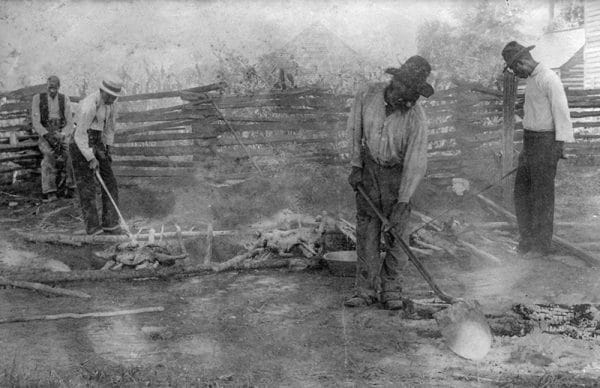 Alabama Barbecue, ca. 1890s
Barbecue, the coming together of fire, smoke, and meat, is one of the oldest cooking techniques known to humankind. The word barbecue itself, most scholars believe, takes its origin from the Taino Indian word babracot, which described the lashed-together wooden structure on which meat was smoked slowly over a grate in the Caribbean. The Spanish morphed the word into barbacoa, which eventually became barbecue. According to food writer Robb Walsh, this method of cooking was first brought to the Carolinas by African slaves in the seventeenth century. Easy to raise and fatten, pigs became the most popular choice of meat for southern barbecuers. Pigs were introduced into the New World by the Spanish in the fifteenth century and into Virginia by the English in the seventeenth.
Alabama Barbecue, ca. 1890s
Barbecue, the coming together of fire, smoke, and meat, is one of the oldest cooking techniques known to humankind. The word barbecue itself, most scholars believe, takes its origin from the Taino Indian word babracot, which described the lashed-together wooden structure on which meat was smoked slowly over a grate in the Caribbean. The Spanish morphed the word into barbacoa, which eventually became barbecue. According to food writer Robb Walsh, this method of cooking was first brought to the Carolinas by African slaves in the seventeenth century. Easy to raise and fatten, pigs became the most popular choice of meat for southern barbecuers. Pigs were introduced into the New World by the Spanish in the fifteenth century and into Virginia by the English in the seventeenth.
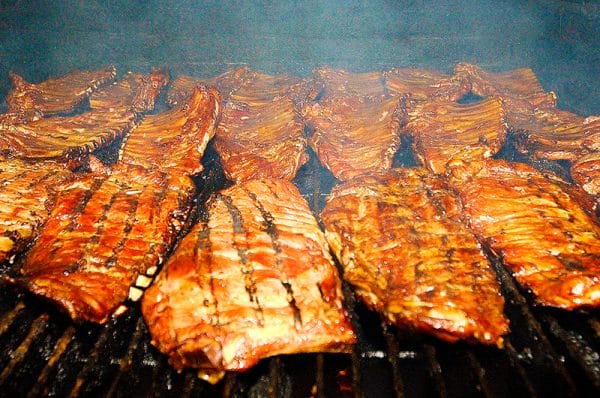 Southern Barbecue
During difficult economic times in the South, barbecueing was an inexpensive way for the working-class to bring flavor and tenderness to even the most inexpensive cuts of meat. Barbecue has remained true to its blue-collar origins and is often the centerpiece of Saturday-afternoon football tailgate parties, political rallies, family reunions, rural church fundraisers, and impromptu backyard parties throughout Alabama and beyond. The word barbecue can be a verb describing the act of cooking and a noun describing both the product and the social gathering where it is consumed. Barbecue differs from grilling in that barbecue typically means long cooking over low heat, whereas grilling is done quickly over higher temperatures.
Southern Barbecue
During difficult economic times in the South, barbecueing was an inexpensive way for the working-class to bring flavor and tenderness to even the most inexpensive cuts of meat. Barbecue has remained true to its blue-collar origins and is often the centerpiece of Saturday-afternoon football tailgate parties, political rallies, family reunions, rural church fundraisers, and impromptu backyard parties throughout Alabama and beyond. The word barbecue can be a verb describing the act of cooking and a noun describing both the product and the social gathering where it is consumed. Barbecue differs from grilling in that barbecue typically means long cooking over low heat, whereas grilling is done quickly over higher temperatures.
 Big Bob Gibson’s White Sauce
Alabama lies between the barbecue poles of Memphis and the Carolinas. In northern Alabama, vinegar-based sauces akin to those in eastern North Carolina are found, but they become scarce south of Birmingham. Variations of tomato-based sauces that bear a kinship to those served from Memphis to eastern Tennessee are served throughout the state. In eastern Alabama, mustard, a South Carolina influence, finds its way into spicy sauces, often in combination with tomato products. One emblematic aspect of Alabama barbecue is a white sauce of mayonnaise, apple cider vinegar, lemon juice, black pepper, and salt. It was created in Decatur by Robert Gibson at Big Bob Gibson’s Bar-B-Q restaurant in 1925. The white sauce has evolved from a kitchen staple to a table condiment, and its use has expanded beyond chicken, with diners often squirting it on pork shoulder. Originally, cooks dunked chickens in the sauce and employees joked that chickens were baptized in it.
Big Bob Gibson’s White Sauce
Alabama lies between the barbecue poles of Memphis and the Carolinas. In northern Alabama, vinegar-based sauces akin to those in eastern North Carolina are found, but they become scarce south of Birmingham. Variations of tomato-based sauces that bear a kinship to those served from Memphis to eastern Tennessee are served throughout the state. In eastern Alabama, mustard, a South Carolina influence, finds its way into spicy sauces, often in combination with tomato products. One emblematic aspect of Alabama barbecue is a white sauce of mayonnaise, apple cider vinegar, lemon juice, black pepper, and salt. It was created in Decatur by Robert Gibson at Big Bob Gibson’s Bar-B-Q restaurant in 1925. The white sauce has evolved from a kitchen staple to a table condiment, and its use has expanded beyond chicken, with diners often squirting it on pork shoulder. Originally, cooks dunked chickens in the sauce and employees joked that chickens were baptized in it.
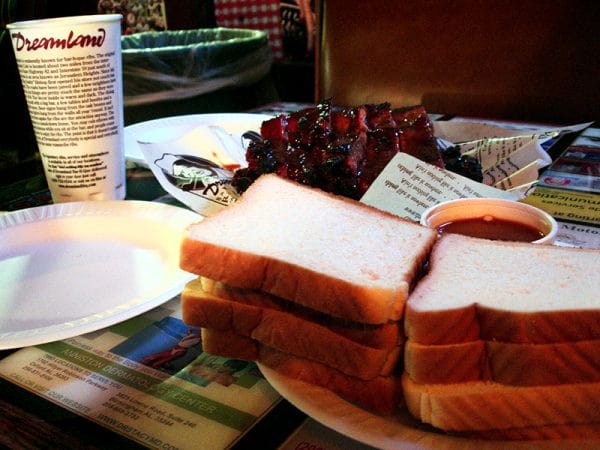 Dreamland Ribs
Dreamland Bar-B-Que is the most renowned establishment in the Tuscaloosa area. It was founded in 1958 by John Bishop. The early menu consisted of nothing more than ribs, white bread, chips, and drinks. A rib sandwich was three ribs atop commercial loaf bread. The sauce was redolent of vinegar but with a tomato underpinning. Although Bishop died in 1997, his family has continued the tradition and expanded the restaurant into other Alabama cities such as Birmingham, Northport, Huntsville, and Mobile, and even into Georgia.
Dreamland Ribs
Dreamland Bar-B-Que is the most renowned establishment in the Tuscaloosa area. It was founded in 1958 by John Bishop. The early menu consisted of nothing more than ribs, white bread, chips, and drinks. A rib sandwich was three ribs atop commercial loaf bread. The sauce was redolent of vinegar but with a tomato underpinning. Although Bishop died in 1997, his family has continued the tradition and expanded the restaurant into other Alabama cities such as Birmingham, Northport, Huntsville, and Mobile, and even into Georgia.
Alabama barbecue was once the subject of a United States Supreme Court case. The McClung family, owners of Ollie’s Barbecue in Birmingham, brought suit in federal court to prevent enforcement of the Civil Rights Act of 1964. The public accommodation clause of the law stipulated that businesses involved in interstate commerce could not discriminate based on race. The Supreme Court ruled against the McClungs on December 14, 1964, thereby allowing African Americans to dine at Ollie’s.
In the steel mill town of Bessemer, the Sykes family has been in the food business since 1956, first serving hamburgers, then converting to barbecue, which is still smoked in a pit inside the front door of the restaurant. Van Sykes, son of the original owner and current proprietor of Bob Sykes BarB-Q, has echoed the views of many Alabama barbecue pitmasters in noting that the “secret” of good barbecue is the interaction of simply salt, meat, and fire. Sykes’ sandwiches, like many across the state, can be stuffed with interior sections of meat, the crust from the charred outside, or, as many diners prefer, a combination of the two.
Irondale’s Golden Rule is one of the state’s oldest restaurants, although it has had a number of owners. It was founded in 1891 by the Williams family and became a popular stop for barbecue and beer on Highway 78, the road to Atlanta. In the 1930s, electrician Jabo Stone married Ellene Williams, and the couple ran the restaurant until 1969, when it was purchased by Michael Matsos. Golden Rule’s barbecue is first cooked in a smoker that holds 600 pounds of meat at a time and then finished on a pit. The Greek-owned restaurant offers several styles of sauce that have evolved as the franchise has grown throughout the South. The restaurant licensed its first franchise in 1976, and the chain has now expanded to 12 other locations in the Southeast.
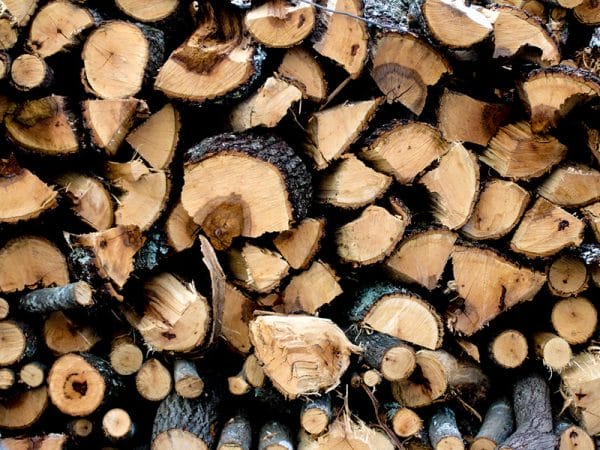 Hickory Wood
At Chuck’s Bar-B-Q in the former mill town of Opelika, the connection between barbecue and religion is most clear. Employees wear T-shirts with “Jesus, The Bread of Life” printed on the back, and beside the cash register, owner Chuck Ferrell’s religious handouts proclaim “Something Better Than Barbecue.” Chuck’s has been serving chopped pork butts since 1976, and the restaurant has popularized mustard-based barbecue sauce in that section of eastern Alabama. Over oak, hickory, and sometimes pecan wood, Ferrell smokes Boston butt with fat and bone removed. Sliced and chopped are serving options, as well as “chipped on the block,” a finer cut and the owner’s personal preference.
Hickory Wood
At Chuck’s Bar-B-Q in the former mill town of Opelika, the connection between barbecue and religion is most clear. Employees wear T-shirts with “Jesus, The Bread of Life” printed on the back, and beside the cash register, owner Chuck Ferrell’s religious handouts proclaim “Something Better Than Barbecue.” Chuck’s has been serving chopped pork butts since 1976, and the restaurant has popularized mustard-based barbecue sauce in that section of eastern Alabama. Over oak, hickory, and sometimes pecan wood, Ferrell smokes Boston butt with fat and bone removed. Sliced and chopped are serving options, as well as “chipped on the block,” a finer cut and the owner’s personal preference.
 Barbecuing Chicken
Alabama barbecuers have come into the business through varied and circuitous routes. Chuck Ferrell once repaired looms. Leo Headrick, who opened the Green Top in Dora with his wife Susie, once mined coal. Rudolph McCollum, founder of Winfield‘s The Spare Rib, spent 32 years as a schoolteacher in Fayette. Gerald Atchison, owner of Sho’nuff BBQ in Alexander City, sold live bait before converting to barbecue. Bob Sykes sold bread. These individuals are representative of numerous Alabama barbecue cooks who are committed to keeping a southern tradition alive, despite modern-day pressures to take shortcuts. Among all the variations in cooking techniques, sauce ingredients, and side dishes, persistence and patience are common characteristics.
Barbecuing Chicken
Alabama barbecuers have come into the business through varied and circuitous routes. Chuck Ferrell once repaired looms. Leo Headrick, who opened the Green Top in Dora with his wife Susie, once mined coal. Rudolph McCollum, founder of Winfield‘s The Spare Rib, spent 32 years as a schoolteacher in Fayette. Gerald Atchison, owner of Sho’nuff BBQ in Alexander City, sold live bait before converting to barbecue. Bob Sykes sold bread. These individuals are representative of numerous Alabama barbecue cooks who are committed to keeping a southern tradition alive, despite modern-day pressures to take shortcuts. Among all the variations in cooking techniques, sauce ingredients, and side dishes, persistence and patience are common characteristics.
 Barbecue Pork
Pride in the craft is evident, too, in the many boastful slogans found on restaurants. A sign at Mobile’s Brick Pit proclaims, “Welcome to the Best Damn Smoked Bar-B-Que in the Great State of Alabama,” and crimson red signatures on the restaurant’s walls echo the theme as diners create odes to the 30-hour-smoldered meat. Of Dreamland’s ribs, the restaurant’s advertising asserts, “Ain’t Nothing Like ’em Nowhere.” In Alabama, barbecue is ecumenical. It is both urban and rural, black and white, tomato-sweet and vinegar-sour, pulled and chopped. It is cinder-block simple and strip-mall slick. A product of the working-class culture of the mills and factories, integrating all, it is one of the state’s most unifying and enduring symbols.
Barbecue Pork
Pride in the craft is evident, too, in the many boastful slogans found on restaurants. A sign at Mobile’s Brick Pit proclaims, “Welcome to the Best Damn Smoked Bar-B-Que in the Great State of Alabama,” and crimson red signatures on the restaurant’s walls echo the theme as diners create odes to the 30-hour-smoldered meat. Of Dreamland’s ribs, the restaurant’s advertising asserts, “Ain’t Nothing Like ’em Nowhere.” In Alabama, barbecue is ecumenical. It is both urban and rural, black and white, tomato-sweet and vinegar-sour, pulled and chopped. It is cinder-block simple and strip-mall slick. A product of the working-class culture of the mills and factories, integrating all, it is one of the state’s most unifying and enduring symbols.
Additional Resources
Edge, John T. Southern Belly: The Ultimate Food Lover’s Guide to the South. Athens, Ga.: Hill Street Press, 2002.
Edge, John T. The New Encyclopedia of Southern Culture. Vol. 7, Foodways. Chapel Hill, N.C.: University of North Carolina Press, 2007.
Egerton, John. Southern Food: At Home, on the Road, in History. New York: Alfred A. Knopf, 1987.
Tapper, Monica. A Culinary Tour Through Alabama History. Charleston, S.C.: The History Press, 2021.



